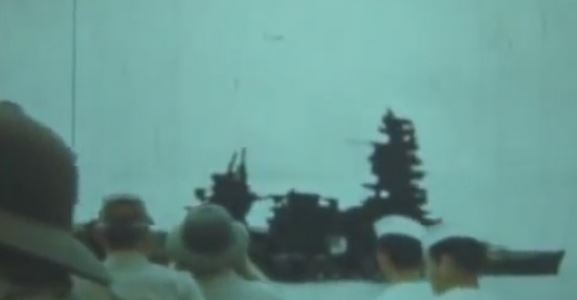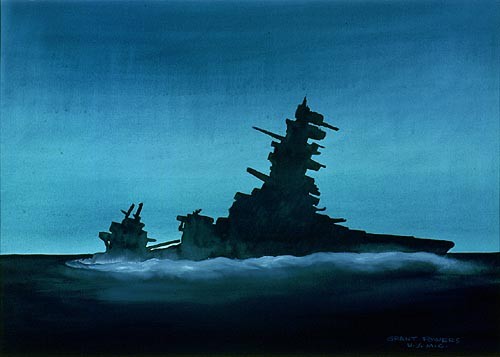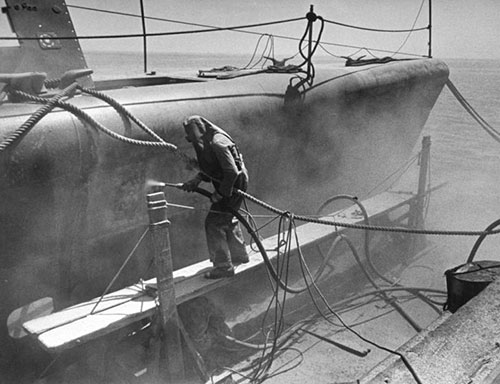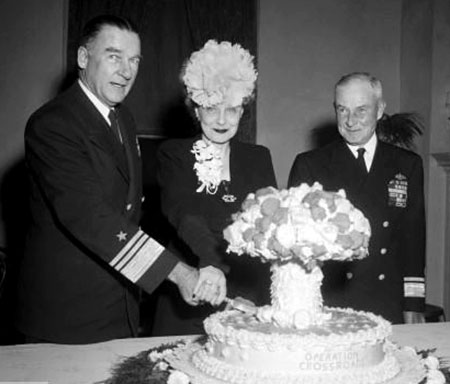
Nagato seemed all right after the Baker blast, though the Radiological Control officers told us it was unsafe to go aboard. We circled her in the land craft, and it was hard to believe that our erstwhile home was now emitting dangerous radiation. She appeared a little lower in the water, as if some seams had been opened, and I suspected she was taking on water. There was nothing that could be done, since we could not activate the pumps nor perform even the most routine damage control.
She sank lower in the water every day as the VADM Blandy’s experts tried to figure out what to do about salvaging the ships still afloat for the CHARLIE Test.
Some ships, less radioactive than ours were boarded, and attempts were made to hose them down. Our pirate crew was parceled out for the clean-up of the fleet, and we never came together as a crew again.
By the morning of the 29th Nagato was gone. No one saw her go, but she had been there at taps on the evening of the 28th and by morning she wasn’t there. Combat Artist Grant Powell depicted the moment she groaned and gave it up to the deep:

By July 30, many target ships remained too radioactive for boarding, and it was becoming apparent that the target fleet was much more heavily contaminated than had been expected. For all but 12 target vessels, the target fleet remained too contaminated to allow more than brief onboard activities. Most of the thorough inspection and documentation of BAKER’s effects, a primary objective of Operation CROSSROADS, was seriously delayed.
Within a week after the detonation, the JTF staff realized that they had to attempt to decontaminate the target vessels, even though the radiation on the targets was completely unexpected, no plans had been prepared for organized decontamination measures.

Beginning on August 1, the morning the battleship had taken her leave, work crews drawn from the target ships companies sprayed and scrubbed the ships exteriors.
Initially, decontamination proceeded slowly because “safe time” aboard some of the target ships was severely limited, sometimes to only a few minutes. Also, removing the radioactive particles embedded in the paint, rust, and organic materials of the ships was a very slow and labor-intensive process. Crews experimented with a variety of techniques and decontaminating agents – including blasting with ground coconut shells, rice, ground coffee, and sand – but none worked well enough to significantly speed up the process.
Radioactive contaminants had spread to the lagoon anchorage of the support fleet. This became a serious problem as contamination accumulated in the ships’ evaporators, saltwater piping, and marine growth on the outside of their hulls, potentially exposing shipboard personnel to low-level radiation.
We worked each day with whatever task the Joint Task Force decided we could manage. It was hot. The sailors mostly were in shorts and worked shirtless. While many of them were issued “dosimeter” badges to record the amount of radioactive exposure they had received, though most of us did not. The priority for issuance was to individuals thought to be at the greatest risk for radiological contamination along with a percentage of each group who were working in less contaminated areas. Personnel were removed for one or more days from areas and activities of possible exposure if their badges showed more than “0.1 roentgens (R)” per day exposure.
They told us that measurement of ionization produced in air by X-Rays or gamma radiation was a good means of assessing exposure to other things, like plutonium from the BAKER core that could not be measured.
They told us at the time that this radiation dose could be tolerated by individuals for long periods without any harmful effects., and there was never any record of what we had dealt with. On the Mount McKinley, there were apparently some tense moments between Admiral Blandy and Dr. Stafford Warren, the Army Colonel in charge of the radiation safety program. He had been Chief of the Manhattan Project’s medical section, and was the only person in a position to take on the Admiral about safety matters. At Operation Crossroads, it was his job to keep the sailors safe during the cleanup, and to avoid giving them grounds to sue the Navy if health problems developed later.
There did not seem to be a viable cleanup plan. Nobody expected that almost the entire target fleet would be bathed in radioactive water, and no decontamination procedures had been tested in advance to see if they would work. The sailors were set to work using traditional deck-scrubbing methods: hoses, mops, and brushes, with water, soap, and lye.
Unprotected sailors were stirring up radioactive material and contaminating their skin, clothing, and, presumably, their lungs. When they returned to their support ship living quarters, they contaminated the shower stalls, laundry facilities, and everything they touched.
By August 3, Colonel Warren concluded the entire effort was futile and dangerous, and demanded an immediate halt to the entire cleanup operation. Blandy disagreed. From what I was told on the trip home, the Admiral did not know that there was no way to detect plutonium, which could have been anywhere. The plan had been to decontaminate the ships and sail them home in triumph after the CHARLIE Test the next year.
It took a week to convince the Admiral. The immediate public relations problem was to avoid any perception that the entire target fleet had been destroyed. On August 6, in anticipation of this development, Blandy had told his staff that ships sunk or destroyed more than 30 days after the Baker shot “will not be considered as sunk by the bomb.” By then, public interest in Operation Crossroads was waning, and the reporters had gone home. The failure of decontamination did not make news until the final reports came out a year later, when we were all home again.
It seemed we had a lot to learn about the atomic age.
CROSSROADS was over.

(Vice Admiral Spike Blandy and his wife cut a mushroom cloud cake, while Admiral Frank J. Lowry looks on at a reception after returning to the States in November 1946. It is not a coincidence about Mrs. Blandy’s hat).
Copyright 2015 Vic Socotra
www.vicsocotra.com
Twitter: @jayare303
